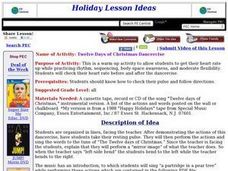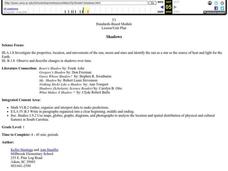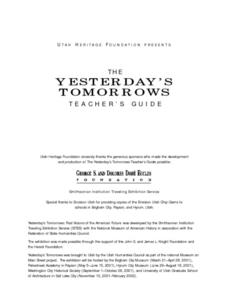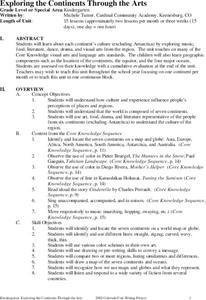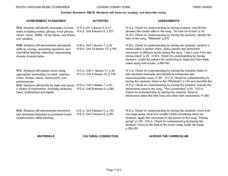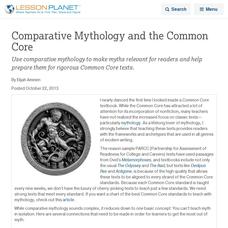Curated OER
Human Body
Fifth graders determine what muscles do and identify the different types. In this muscle lesson, 5th graders discuss what they know about muscles before looking at the book, The Human Body by Jonathan Miller. They take a teacher made...
Curated OER
Forming Relationships Using Music & Rhythm
Students make connections to other cultures and traditions through music, dance, art, and poetry.
Curated OER
Twelve Days of Christmas Dancercise
Students participate in a dance routine set to the song The Twelve Days of Christmas. They monitor their heart rate and learn a new song.
Curated OER
Shadows
First graders measure how a shadow changes over the course of a day. They write about what they would do if they lost their shadow, and make silhouettes of themselves. Students make up a shadow dance and read stories about shadows.
Curated OER
Buh Bee and Duh Dee
Learners differentiate between /b/ and /d/ in both written and spoken words. They listen to the /buh/ and /duh/ sounds in words, a tongue twister, and in Audrey Wood's, Silly Sally. They recite the tongue twister before writing /b/ and...
Curated OER
REPRODUCTION
Students complete a variety of activities to study different concepts in Science. The activities are part of a layered curriculum. This is used to differentiate instruction and give a wide variety of assessment opportunities.
Curated OER
The Cycle of Life
Eighth graders search for rites of passage in their own lives and study rites of other cultural groups in Louisiana and around the world. They assess how to recognize moments of importance in people's lives and find meaning in the stages...
Curated OER
The Yesterday's Tomorrow Teacher's Guide
Young scholars explore the future and the importance of the past. In this futuristic lesson, students create a future city and identify traditions of their heritage that they feel should be passed on to future generations. They also...
Macmillan Education
Understanding Poetry
William Wordsworth's "Daffodils" provides young poets with an opportunity to examine how a poet can use powerful images and poetic devices to create vivid pictures in the minds of readers.
Study Champs
Nouns
Plural, proper, and common nouns are all included here. After reviewing the definition of a noun and reading an example sentence, learners underline the nouns in each of 15 sentences. Each sentence lists how many nouns are present, so...
K12 Reader
Comparative or Superlative?
Is this the easiest or hardest exercise for practicing superlatives and comparatives? Your class can find out if it's easier or harder than what they've done before by changing the underlined adjectives into comparatives or superlatives,...
Curated OER
Cool Line
Students learn foot and arm patterns, then sequence those patterns into a line dance.
Curated OER
Introduction to Melodic Notation: Sol-Mi
Second graders sing melodic sol-mi songs for teacher and student assessment. Emphasis is placed on drill and practice while developing melodic singing skills. Students evaluate performances and activities using pre-determined rubric...
Curated OER
Multiplication Movement
Third graders experience multiplication facts through movement and music. They view the Multiplication Rock video, choreograph a movement or dance to teach the multiplication facts of threes, and perform their dance.
Curated OER
Exploring the Continents Through the Arts
Students examine the continents and explore geographic components in the fifteen lessons of this unit. The location of the continents, the equator, the four major oceans, and the music, food, literature, dance, and drama from each of the...
Curated OER
Listen to Music
Young scholars listen to, analyze, and describe music. They identify examples of music forms including such as motive phhrase, 4-bar phrase,
canon, and rondo. In addition, they perform a dance called a partner mixer and model the pattern...
Curated OER
"Carnival Overture"
Students assess that music can be used to express feelings and create a story portraying many different feelings based on "Carnival Overture," by Antonin Dvorak. They become more educated listeners as they listen to and interpret...
Curated OER
EXPRESSING AN IDEA
Students explain how elements (body, space, time, and force) can be contrasted to express anger and happiness in movement. They give examples for each of the elements: body actions, speed and force of movement. They display their...
Curated OER
Moving to a Path Map
Learners accurately demonstrate non-locomotor/axial movements such as bend, twist, stretch, swing. They accurately demonstrate eight basic locomotor movements.
Curated OER
Locomotion, Time And Shapes
Young scholars practice the concepts of time and rhythm using drum beats. They also create body shapes using verbal cues. The shapes made include stretched, curled, angular, or twisted. The rhythm of beats is increased or decreased to...
Curated OER
Comparative Mythology and the Common Core
Use comparative mythology to make myths relevant for readers and help prepare them for rigorous Common Core texts.
Curated OER
Action Verbs
Second graders perform various tasks by identifying the action word with teacher. They demonstrate each of the correct critical elements of loco motor, non-manipulative, and manipulative skills.
Curated OER
Sequencing
Are you looking for a way to teach sequence of events in your narrative writing unit? Bring this lesson plan to your middle school class, as it prompts young writers to create a narrative sequence map of events that have happened at...
Teaching Tolerance
Artistic Expression Showcase
No one is too young to create a masterpiece. Elementary artists delve into the topic of social justice with original artwork. Scholars keep journals to reflect on their experiences before putting paintbrush to paper. Final artwork is...
Other popular searches
- Tap Dance Assessment
- Dance Assessment Criteria
- Medieval Dance Assessment
- Dance Assessment Hip Hop
- Dance Assessment Time Tempo
- Composition Dance Assessment
- Modern Dance Assessment




